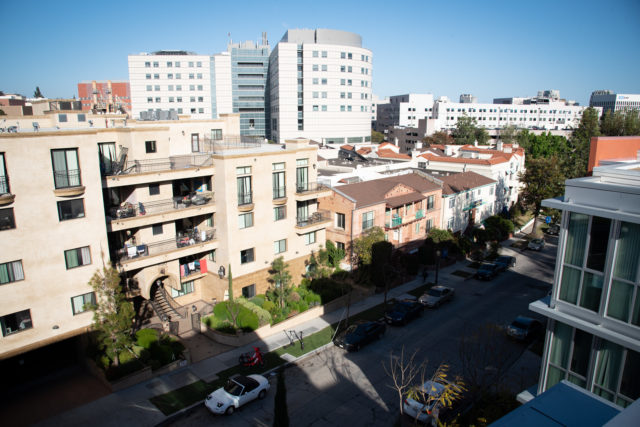This post was updated April 29 at 11:06 p.m.
Andrew Loustalot’s first home at UCLA was the university apartments.
Loustalot, a third-year anthropology student, lives in a four-bedroom, eight-person unit in Palo Verde, a university apartment. UCLA announced Jan. 21 that Palo Verde and some other off-campus apartment buildings will be transitioning to 10 occupants.
UCLA announced in a written statement that for the 2025-2026 year, it would be transitioning a portion of the university’s four-bedroom apartments – which currently house eight students – into 10-person units. Some two-bedroom university apartments will also transition into eight-person apartments.
The university said in the announcement that it made these changes to continue its commitment to guarantee four years of housing to all undergraduate students.
The announcement prompted some campus residents to reconsider their housing options for the coming year. Loustalot said his current roommate group signed up to continue living in university apartments but added that most of them are now looking for housing elsewhere.
Savannah McDade, a third-year political science student, said she is concerned about the quality of life of people who reside in 10-person apartments because of the lack of kitchen and co-living space available.
“Honestly, if you ask anyone that’s living in the apartments, we think it’s pretty inhumane as it is, living with seven other people,” McDade said.
McDade and Loustalot are not the only undergraduate students pursuing private housing options in response to the transition. Derek Kent, a manager for JJ Park apartments, said he has witnessed a significant increase in interest in the company’s buildings.
“I’m not sure what other building owners and managers are experiencing, but if demand like this continues to stay high, then I could definitely see rent prices continuing to increase,” Kent said.
Gregor Schubert, an assistant professor of finance at the UCLA Anderson School of Management, said that by increasing open space in existing units in university apartments, there could be a decrease in demand for private alternatives. However, the particularities of student housing impact this, he added.
“Students may have preferences for very particular housing subtypes, and so UCLA is eliminating some of those, and that will push those students to look for housing of that type from private providers,” Schubert said.
Loustalot said some of his roommates are unable to pursue private options because of financial aid limitations.
“I have roommates that their only option is to really stay within campus-affiliated housing, just because of FAFSA and financial aid covering majority of it,” Loustalot said.
Michael Manville, a professor and chair of the Department of Urban Planning at the Luskin School of Public Affairs, said UCLA’s policy could serve as a reason for the city of Los Angeles to not implement further housing policy.
“Local housing policies traditionally are very hard to move,” Manville said. “And the fact that UCLA has done this, it could easily give the city an excuse not to do anything,”
Manville said he believes the increasing student population will need further response from UCLA and the city of LA in order to meet the future demand for housing.
“But the broader question is the entire Westwood and West LA area is just an extremely expensive place,” Manville said. “It’s good that they’re (UCLA) taking the step, but it would be better if the city did do something alongside UCLA to make it easier to build new housing and make things cheaper for students.”





Comments are closed.